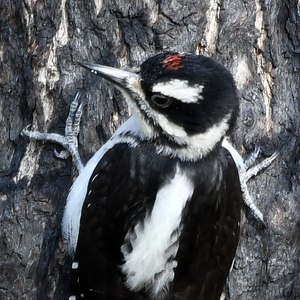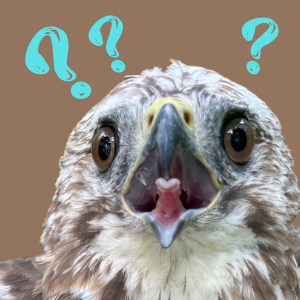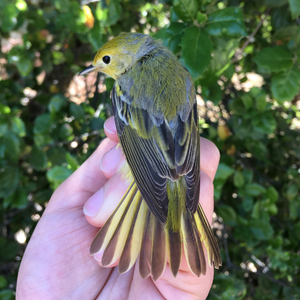The Blue Grosbeak photos were submitted by Dr. Maureen McClung of Hendrix College who banded the bird in early June in central Arkansas.
Passerina buntings (Indigo, Lazuli, Painted, and Varied), now including Blue Grosbeak (which was moved from genus "Guiriaca" some 20 years ago), is probably the most interesting group of North American passerines in terms of molts and plumages. Adults and most hatching-year birds (HYs) undergo substantial "molt migrations," during which most birds leave the summer grounds in worn plumage, stopover on specific molting grounds such as the Mexican Monsoonal region, and then fly to winter grounds at more southerly tropical latitudes following molt (see the results of IBP studies here and here for more information on molt migration).
Second-year (SY) male and female Blue Grosbeaks captured at IBP molt-migration banding stations
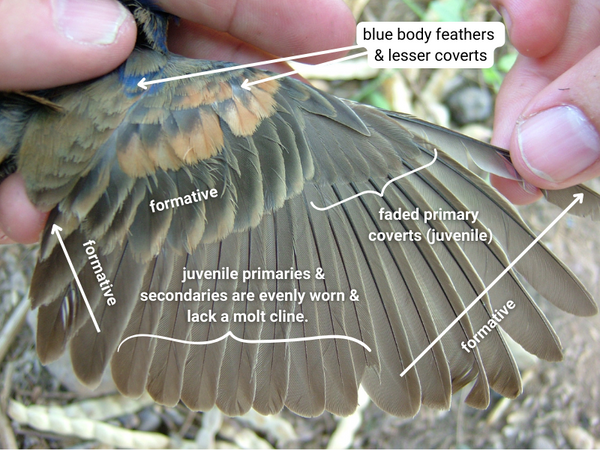
SY male Blue Grosbeak, San Jose de la Pima MoSI Station, Hermosillo, Mexico, 11 July 2007. Note the faded brown primary coverts, eccentric molt pattern, and lack of clines among the unmolted primaries and secondaries. The blue body feathering (just visible) and lesser coverts indicates a male for an SY. Photo: Peter Pyle.

SY female Blue Grosbeak, Tumacacori MAPS station, near Tucson, Arizona, 25 June 2007. This individual shows the same eccentric molt limits and lack of molt cline as the SY male, but the lack of blue in the body plumage and lesser coverts indicates an SY female. Photo: Wade Leitner.

HY birds undergo "eccentric" preformative molts, whereby outer primaries and inner secondaries are replaced whereas juvenile inner primaries and outer secondaries are retained, forming "molt limits" among these tracts that lead to straightforward ageing of second-year birds (SYs) in spring and summer. Prealternate molts range from absent or nearly so in Varied and Painted buntings to quite complete in Indigo Bunting, one of few North American passerines that can replace all secondary coverts during this molt, leading to a rare molt-and-plumage code "A" on MAPS banding sheets for this tract in some individuals. In spring, males of Painted and Varied buntings resemble females whereas males of Indigo and Lazuli buntings acquire the brighter body-feather plumage of adult males to varying degrees, but usually not entirely. If you like brain teasers, see here for a thorough dissection of molts and plumages in Indigo Bunting, including the documentation of an after-second-year (ASY) male having anomalously molted outer primaries during its prealternate molt.
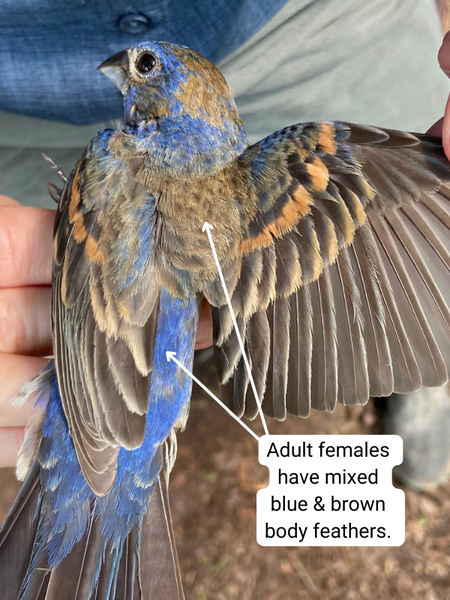
ASY female Blue Grosbeak, Stone Prairie MAPS station, Mayfield Arkansas, 9 June 2022. Note the mixed blue and brown body feathering which, unlike in Indigo Buntings, occurs in ASY female Blue Grosbeaks. Photo: Maureen McClung.
Indigo Buntings and Blue Grosbeaks are similar in plumage, and since the buntings are more commonly caught at MAPS stations than the grosbeaks, there is a tendency to use age and sex criteria of the former for the latter. But there are a few important differences. One is that primary coverts in ASY Indigo Buntings tend to be black with blue edging whereas those of ASY Blue Grosbeaks, especially females, can be brown with only a slight blue wash. For Blue Grosbeaks showing brown primary coverts, one has to assess their quality (full and dark brown in ASYs, worn and very pale brown in SYs) and, importantly, cross-check to see whether or not there are eccentric molt limits among the primaries and secondaries, as described above. Another critical difference is that ASY female Indigo Buntings show brown body feathering whereas those of ASY female Blue Grosbeaks can be mixed blue and brown, resembling that of SY males in both species. Thus, to properly determine the sex of spring Blue Grosbeaks, one must first age them by primary-covert quality and molt-limit criteria, and then sex them by body plumage (although caution that body plumage is also variable, in part due to variation in wearing of brown fringing from formative or basic feathers).
The Arkansas Blue Grosbeak does not show the eccentric patterns among wing feathers. Instead they are uniform in quality and wear, except for what I refer to as a "molt cline" a gradual freshening and darkening of feathers from the outermost secondary (s1) to that next to the tertials (usually s6 but see below), and a similar cline in freshness from innermost (p1) to outermost (p9) primaries. The primary coverts, furthermore, are nice and dark brown with a slight blue tinge. Thus this bird has undergone a complete molt and is an ASY, and once we get to ASY we can sex it as a female due to its mixed brown and blue body plumage. Reversing the script, if we know it is a female by brood patch, the extent of blue body feathering indicates ASY, as SY females tend to have less blue feathering, often none at all. Here are some Macaulay images of each age/sex class in spring. ASY males are, or course, a slam dunk, but for the other three birds check the condition of the primary coverts, presence or absence of eccentric molt limits, and extent of blue to the body feathering: SY female, ASY female, SY male, and ASY male.
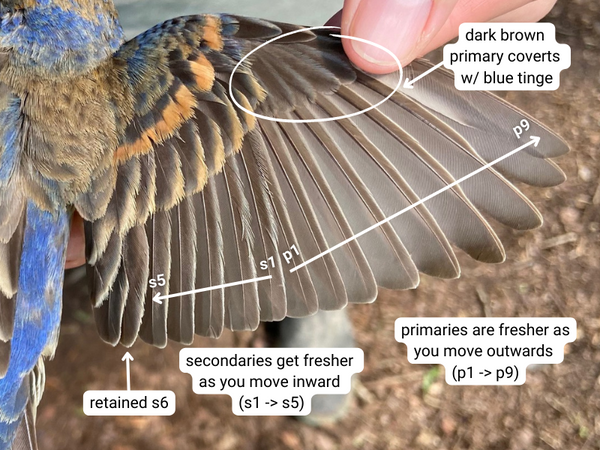
ASY female Blue Grosbeak, Stone Prairie MAPS station, Mayfield Arkansas, 9 June 2022. Note the dark primary coverts with blue tinge and the lack of eccentric molt limits in the primaries and secondaries, and the "molt clines" within each of these tracts. Photo: Maureen McClung.
Interestingly, this grosbeak appears to have retained the s6 from last year, indicating that it underwent an incomplete prebasic molt. Normally this feather is the last replaced and therefore freshest-looking secondary, completing the molt cline from s1 to s6 (rather than just s1 to s5, as here), but here it is more worn than both s5 and s7, indicating that this bird did not quite have enough time last year to finish the molt. This occurs infrequently in ASY birds of some passerines but especially among tanagers and grosbeaks (see here for more information). Because this s6 is in relatively good shape, a basic rather than a juvenile feather, we can actually age this female as an after-third-year (ATY)! This could relate to its more extensive blue feathering in this female as compared with many ASYs, as females of some bird species gradually gain more male-like plumage features as they get older.
Finally, I want to give a shout out to Dan Froelich's (2009) Ageing North American Landbirds by Molt Limits and Plumage Criteria, now available in full online via IBP's publications database. This reference was complied while Dan was working for IBP and presents a very useful summary of ageing banded birds by molt limits using photos taken at MAPS stations. Check out the Indigo Buntings in Figures 17, 31, and 32 but, more importantly, can you answer Dan's photo quiz in Figure 34? Here's a hint: after reading this piece, I bet you can!




